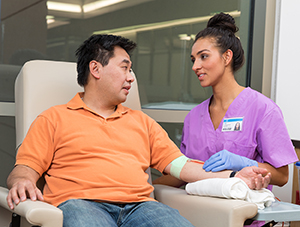A
B
C
D
E
F
G
H
I
J
K
L
M
N
O
P
Q
R
S
T
U
V
W
X
Y
Z
Click a letter to see a list of conditions beginning with that letter.
Click 'Topic Index' to return to the index for the current topic.
Click 'Library Index' to return to the listing of all topics.
Blood Donations and Blood Banking
What is blood banking?
A blood bank is a place where blood is collected and stored before it is used for transfusions. Blood banking takes place in the lab. This is to make sure that donated blood and blood products are safe before they are used. Blood banking also determines the blood type. The blood is also tested for infectious diseases.

Facts about blood banking
According to the American Red Cross:
-
About 36,000 units of blood are needed every day.
-
The number of blood units donated is about 13.6 million a year.
-
About 6.8 million volunteers are blood donors each year.
-
Each unit of blood is broken down into components. These are red blood cells, plasma, cryoprecipitated AHF (cryo), a white blood cell called a granulocyte, and platelets. One unit of whole blood and its parts may be transfused to several people. Each person may have a different need.
-
More than 21 million blood components are transfused each year.
Who are the blood donors?
Most blood donors are volunteers. But you may also donate blood several weeks before having surgery. This is so that your blood is available in case you need a transfusion. Donating blood for yourself is called an autologous donation.
Volunteer blood donors must meet certain criteria. These include:
-
Must be at least 16 years of age, or the minimum age set by state law
-
Must be in good health
-
Must weigh at least 110 pounds
-
Must pass the physical and health history exam given before donation
Some states let people younger than 16 or 17 years to donate blood, with parental consent.
What tests are done in blood banking?
Certain standard tests are done in the lab once blood is donated. These include:
-
Typing. This is blood type. Blood can be A, B, AB, or O.
-
Rh typing. This can be Rh positive or Rh negative.
-
Screening for any unexpected red blood cell antibodies. These antibodies may cause problems in the person getting the blood.
-
Screening for current or past infections. The list includes:
Blood cells are treated with radiation. This kills any T-lymphocytes in the donated blood. T-lymphocytes can cause a reaction when transfused. They can also cause graft-versus-host problems. This is a rare complication of a blood transfusion.
Blood may also be filtered to remove certain white blood cells called leukocytes (leukocyte-reduced blood). These cells contain antibodies that can cause fevers in the person getting the transfusion. After getting several transfusions, the person may be at higher risk for a reaction.
What are the blood types?
According to the AABB, blood types make up the following portions of the U.S. population:
-
O Rh-positive - 39%
-
A Rh-positive - 30%
-
B Rh-positive - 9%
-
O Rh-negative - 9%
-
A Rh-negative - 6%
-
AB Rh-positive - 4%
-
B Rh-negative - 2%
-
AB Rh-negative - 1%
What are the components of blood?
Blood or 1 of its components may be transfused. Each component serves many functions.
-
Red blood cells. These cells carry oxygen to the tissues in the body. They are commonly used to treat anemia.
-
Platelets. They help the blood clot. They are used to treat leukemia and other forms of cancer.
-
White blood cells. This is a type of white blood cell that helps fight infection. It helps in the immune process.
-
Plasma. This is the watery, liquid part of the blood. Red blood cells, white blood cells, and platelets are a part of this liquid. Plasma is needed to carry the many parts of the blood through the bloodstream. Plasma serves many function. It is generally transfused to replace blood-clotting proteins.
-
Cryoprecipitate AHF. The party of the plasma that contains clotting factors that help control bleeding.
Albumin, immune globulins, and clotting-factors may also be separated and processed for transfusions.
Online Medical Reviewer:
L Renee Watson MSN RN
Online Medical Reviewer:
Marianne Fraser MSN RN
Online Medical Reviewer:
Todd Gersten MD
Date Last Reviewed:
4/1/2022
© 2000-2024 The StayWell Company, LLC. All rights reserved. This information is not intended as a substitute for professional medical care. Always follow your healthcare professional's instructions.